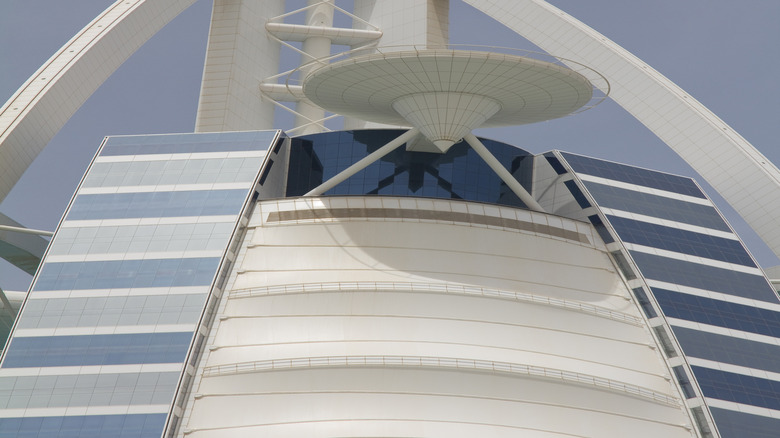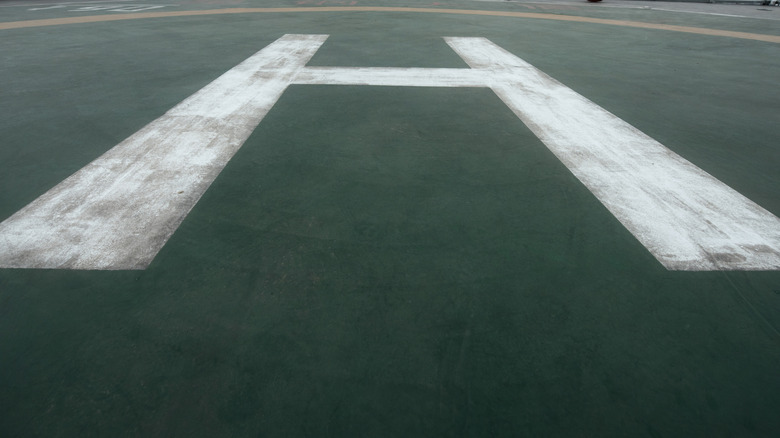Can A Plane Land On A Helipad? It's Only Happened Once
A helipad, as the name would imply, is typically for helicopter use. The giant letter 'H' in its center is there for a reason, after all. In general, airplanes need an awful lot more room to land than a helicopter does, which is why airplane runways can stretch upwards of 3 miles. However, many people probably think of huge passenger airliners when they think of airplanes because those are the ones that most of us are familiar with. It would be impossible to land a Boeing 737 on a helipad, as the size of this plane itself is bigger than most helicopter pads. But that's not to say that there aren't smaller, more maneuverable models that could pull off such a feat.
Only one airplane is ever known to have landed successfully on a helipad, and it was a Carbon Cub flown by Polish aviator Łukasz Czepiela. His aircraft, at approximately 23 feet in length, was well-suited to the tremendous task dimension-wise. And when he pulled this off on March 14, 2023, he certainly chose an illustrious helipad on which to immortalize himself in aviation history.
The setting for his triumph was the Burj Al Arab Jumeirah in Dubai, a prestigious hotel that sports a helipad (pictured above) approximately 695.5 feet above ground level. It was a seemingly impossible and potentially fatal mission, with Czepiela addressing the scale of the task after his triumphant return: "Landing at the height of 200 meters, with no clear points of reference, is completely different from landing on the ground," he said, per Red Bull. "I had to fully trust my own skills. On the helipad, there was no room for mistakes." As it happened, his skills were more than up to the task.
How Łukasz Czepiela achieved the impossible
Needless to say, this isn't something that can be attempted without intense preparation on behalf of both pilot and aircraft. A huge factor that made this even plausible was the compact and lightweight nature of the plane. In fact, its weight was streamlined down to about 937 pounds in preparation for the big landing. By contrast, Boeing's 777-300ER has a maximum takeoff weight of close to 775,000 pounds. You wouldn't get one of those on a helipad, that's for certain.
Unprecedented as Łukasz Czepiela's mission was, it was also something to be meticulously practiced and prepared for. He engaged in 650 test runs over a two year period and was a veteran pilot, but there was still just no way to absolutely ensure success, or even safety. Pilot Mike Patey told Red Bull, "There are always circumstances that you can't control ... there's always unknowns. Maybe some weird wind ... a strange gust, some kind of ... current off the side of the building." Nonetheless, Patey went on, "safety parameters for wind limitations" had been established to provide the safest environment possible for the attempt.
In the Red Bull video above, Czepiela shows some of his practice attempts on a runway with markings that exactly matched the size of the Burj Al Arab Jumeirah's helipad. The video then cuts to the attempt itself, and several runs are shown. In one, the pilot's approach is too fast and he pulls away for another, with a dejected "I'm not sure we can do it." In short order, though, a successful landing is made with space to spare.
Some other aircraft could potentially pull this off
Łukasz Czepiela's prolific practice and great skill allowed him to land on the helipad with a bit of wiggle room. He also had the tremendous advantage that his Carbon Cub was modified for the role. Patey, who was instrumental in preparing the aircraft for its attempt, told Red Bull, "We built it ... specific to do this task and be able to do it successfully every time." This process involved using lightweight titanium components wherever possible, as well as adjusting the internals to ensure that Czepiela could brake quickly enough to come to a complete stop on such a tiny platform.
There are other aircraft that could, theoretically, achieve this rather more practically. Rotor aircraft like helicopters aren't the only ones that can perform vertical landings. Very unique aircraft known as VTOL (Vertical Takeoff and Landing) and STOVL (Short Takeoff and Vertical Landing) can do the same thing. The F-35B Lightning II, for instance, can land similarly to the iconic Harrier. Only in particular circumstances could this work, though, as the helipad in question would need to be large enough and sturdy enough to support it. There aren't many fighter jets that can take off and land without a runway, but it's possible.
VTOL and STOVL capabilities may be rather niche, but they're incredibly valuable. Fighters like the F-35B, by their nature, may have to perform landings on the decks of aircraft carriers. These are similarly cramped conditions to those they may have to use in a theoretical helipad landing. For Czepiela, though, achieving such feats is about believing in a dream. As he states on his website, "Bringing [dreams] to realization is not as difficult as it may seem."

